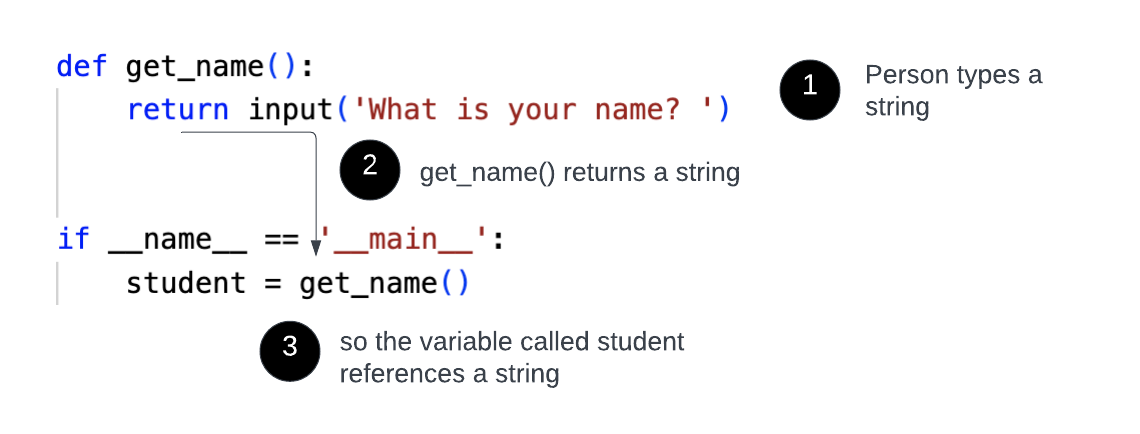Types and operators
As you learn to program, it is helpful to understand some basic concepts that are common to all programming languages. Here we are going to cover types and operators.
Types
Every value in Python has a type. We are going to cover three basic types: string, integer, and boolean.
String
We have been using strings for some time, such as when we paint the color
'blue':
bit.paint('blue')The type for the value 'blue' is a string.
We have also seen strings when using input():
student = input('What is your name? ')If the person running your program types Emma, then the variable student
references the string 'Emma'.

You can do likewise see this in the following code, where we directly set
student equal to 'Emma':
student = 'Emma'Remember that functions can return values. So in this code:
def get_name():
return input('What is your name? ')
if __name__ == '__main__':
student = get_name()the variable student again has a type of string. This is because
get_name() returns whatever input() returns, and input() returns a string:

Integer
Another type in Python is integer. You can see this below:
number = 5Here, the variable number references the integer 5.

Note that there are no quotes around 5! If you instead type:
number = '5'Then, the variable number now references the string '5'.
Just like with strings, functions can return integers:
def get_a_seven():
return 7
if __name__ = '__main__':
number = get_a_seven()Here, get_a_seven() is a function that always returns 7, which is an integer.
Likewise, the variable number eventually references the same number 7.
Boolean
Finally, when you use True or False, then these have the boolean type. For
example:
having_a_great_time = TrueHere, the value having_a_great_time references the boolean True.

Likewise, we can have a function that returns a boolean:
def i_am_hungry():
return True
if __name__ == '__main__':
if i_am_hungry():
print('Now eating a salad')Here, the function i_am_hungry() returns True, which is a boolean, and
because that boolean is True, the program will print Now eating a salad.
Summary
| Value | Type |
|---|---|
| ‘hello’ | string |
| “why not?” | string |
| 3 | integer |
| True | boolean |
| False | boolean |
Operators
The type of a variable determines which operators you can use with it and what those operators do.
Plus
For example, we can add integers with the + operator, and this works as you
would expect:
if __name__ == '__main__':
print(10 + 7)This will print 17.
It may surprise you that in Python we can also use the + operator on strings:
if __name__ == '__main__':
print('fire' + 'place')This will print fireplace, because for strings the + operator concatenates
them.
Minus
You can use the - operator to subtract integers:
if __name__ == '__main__':
print(10 - 7)This will print 3.
But you cannot use the - operator on strings! If you try it:
if __name__ == '__main__':
print('fire' + 'place')you will see this error:
Traceback (most recent call last):
File "/Users/zappala/cs110/unit3/test.py", line 2, in <module>
print('fire' - 'place')
~~~~~~~^~~~~~~~~
TypeError: unsupported operand type(s) for -: 'str' and 'str'This is telling you that - is an “unsupported operand” in between the types
‘str’ (string) and ‘str’ (string).
Equality
Two check whether two values are equal, use two equal signs, ==. Equality is
a comparison operator, meaning you use it to compare two values:
if __name__ == '__main__':
number = 5
if number == 3:
print('Your number is 3')
elif number == 5:
print('Your number is 5')Here, we first try number == 3, which is False. We next try number == 5,
which is True. So this program will print: Your number is 5.
Try changing the first line of the main block to set number to a different
value.
Similar to integers, we can use == to compare strings:
if __name__ == '__main__':
your_pet = 'cat'
if your_pet == 'dog':
print('A dog is a good second-best pet!')
elif your_pet == 'cat':
print('A cat is the best pet!')
Here, we first try your_pet == 'cat', which is False. We next try
your_pet == 'cat', which is True. So this program will print:
A cat is the best pet!.
Greater than and less than
Both < and > are also comparison operators.
We can use > to check if one value is greater than another:
if __name__ == '__main__':
number = 7
if number > 10:
print('Your number is too high.')
elif number > 5:
print('Your number is just right.')
else:
print('Your number is too low.')This will run the first comparison, number > 10, and it evaluates to False.
The second comparison evaluates to True, so the program prints:
Your number is just right.
We can likewise use < to compare values:
if __name__ == '__main__':
number = 7
if number < 5:
print('Your number is too low.')
else:
print('Your number is high enough')We can also use > and < to compare strings. This will do an alphabetical
comparison for you. For example:
if __name__ == '__main__':
animal1 = 'alligator'
animal2 = 'zebra'
if animal1 < animal2:
print("Animal 1 comes before animal 2")This will print Animal 1 comes before animal 2.